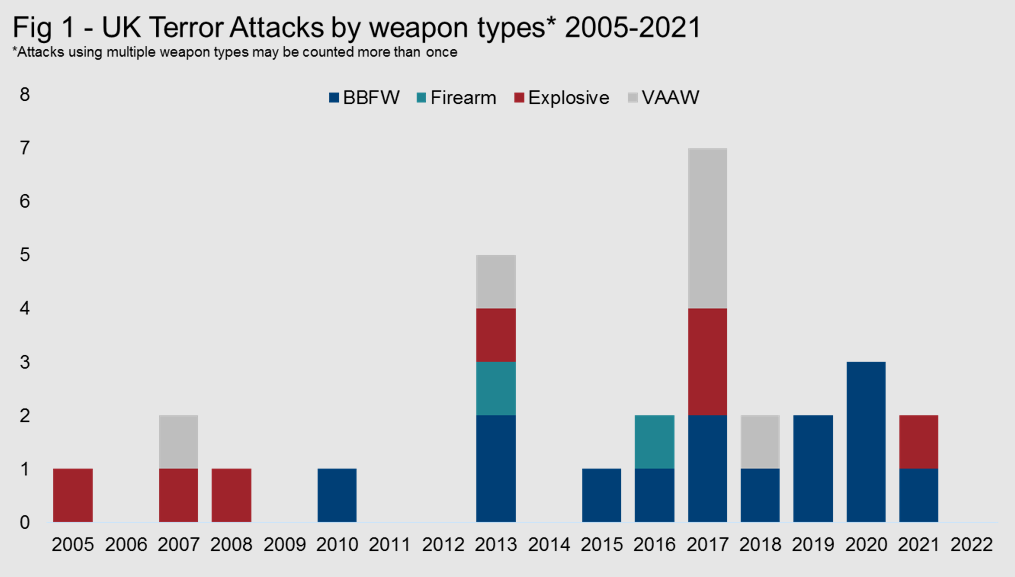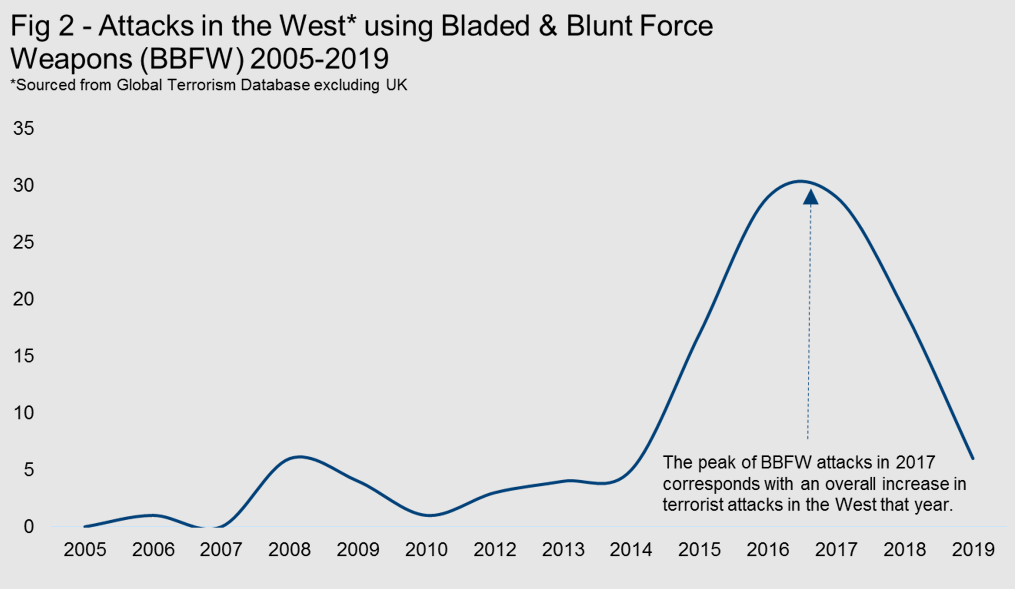Headline Assessment
-
A bladed or blunt force weapon (BBFW) is the most likely attack methodology if either an Islamist or Extreme Right Wing Terrorist (ERWT) attack were to occur in the UK. Such weapons are easy to acquire and use without training.
-
It is highly likely that any future BBFW attack will make use of common kitchen knives which are widely available compared to other bladed weapons.
-
A BBFW attack motivated by an Islamist ideology will likely occur in publicly accessible places, whereas Extreme Right-Wing terrorists will highly likely favour those areas where individuals who are perceived to align with their grievance are likely to be found.
What is a Bladed or Blunt Force Weapon (BBFW)?
Bladed weapons refer to a variety of weapon type including knives, swords, axes and machetes. Blunt force weapons include tools and implements that can be used as weapons such as hammers, picks, clubs, bats etc.
BBFW Attacks in the UK
Up until relatively recently, terrorist attacks in the UK were characterised by complex plots, often directed from overseas and largely employing explosives. Over the last decade there has been a trend of terrorists mounting attacks in the UK using simpler methodologies, principally bladed or blunt force weapons.
A bladed or blunt force weapon (BBFW) is the most likely attack methodology if either an Islamist or Extreme Right Wing Terrorist (ERWT) attack were to occur in the UK. Such weapons are easy to acquire and use without training.

One of the first BBFW attacks to take place in the UK was in 2010 when MP Stephen Timms was stabbed by a lone attacker during a constituency surgery. Since 2010, attack plots in the UK featuring BBFWs and other less sophisticated methodologies such as Vehicle as a Weapon (VAAW) and Fire as a Weapon (FAAW) have consistently accounted for at least half the total in any given year. Notable BBFW attacks have included the following:
| Year | Location | Details |
|---|---|---|
| 2013 | Woolwich, London | Soldier Lee Rigby murdered by two attackers armed with a machete |
| 2017 | London Bridge, London | Six people killed by three marauding knife attackers |
| 2019 | Stanwell, Surrey | Lone attacker stabbed Bulgarian national |
| 2021 | Southend, Essex | Sir David Amess MP stabbed to death at his constituency surgery |
In almost every case, attacks using BBFWs have been carried out by Self-Initiated terrorists (S-ITs). The use of less sophisticated methodologies has been observed in attacks carried out by Extreme Right-Wing Terrorists, as well as Islamist Extremists. To date there have been no UK attacks motivated by Left, Anarchist and Single Issue Terrorist (LASIT) ideology.
BBFW Attacks in the West
The UK trend of increased BBFW attacks reflects a trend observed in terrorist attacks in the West (Western Europe, North America and Australasia). More broadly the West has experienced a notable increase in attacks using BBFWs since 2014 (see Figure 2).

Why has the use of BBFW in terrorist attacks increased?
Some likely factors contributing to this rise of BBFW attacks in the West include:
-
Terrorist propaganda from mid-2014 onwards promoting the use of simple methodologies by terrorists in the West
-
A speech in September 2014 by a prominent spokesperson for a terrorist group , who encouraged supporters to conduct attacks in their home countries by any means possible, including with a knife
-
In May 2016, an English-language magazine produced by a terrorist organisation overseas urged followers to conduct bladed weapon attacks
While there is some evidence of Extreme Right-Wing Terrorists exploiting online terrorist instructional material from Islamist sources, it is unclear the extent to which this has influenced their choices of methodology, which may have been based on practicality and availability.
Weapons and Lethality
It is highly likely that any future BBFW attack will make use of common kitchen knives that are widely available.
BBFW attackers in the UK have overwhelmingly used knives in their attacks, most commonly carving or kitchen knives. In only two cases have a cleaver or an improvised bladed weapon been used. The majority of BBFW attacks have resulted in a small number of fatalities. Only where attacks have incorporated other methodologies have casualties been higher, such as the Westminster Bridge attack of 2017 where a vehicle was also used as a weapon.
Targeting
A BBFW attack motivated by an Islamist ideology will likely occur in publicly accessible places, whereas Extreme Right-Wing terrorists will highly likely favour those areas where individuals who are perceived to align with their grievance are likely to be found.
To date, the selection of targets by attackers using BBFW have largely depended on the underlying motivating ideology. Extreme Right Wing Terrorists account for only three attacks since 2010 where BBFW have been used; two of these targeted members of minority communities, the target of the third being an MP.
The remaining 11 BBFW attacks in the UK since 2010 have been motivated by an Islamist Extremist ideology and have mostly occurred in publicly accessible locations. For example, the 2017 marauding attack took place in a busy street market close to London Bridge station, targeting ordinary citizens.
Notably, five of these attacks have targeted what are perceived as representatives of the state; two Members of Parliament, a soldier, a police officer and a prisoner officer.
Probability and Likelihood in Intelligence Assessments
When describing threats in intelligence assessments, Counter Terrorism Policing utilises the Probabilistic Yardstick.
The Probabilistic Yardstick is a tool created by the Professional Head of Intelligence Analysis (PHIA), in the UK government, to standardise the way in which we describe probability in intelligence assessments. For example, if we use the term ‘likely’ what we mean is ‘a 55-75% chance’.
Use the scale below as a reference when reading ProtectUK Insights.


